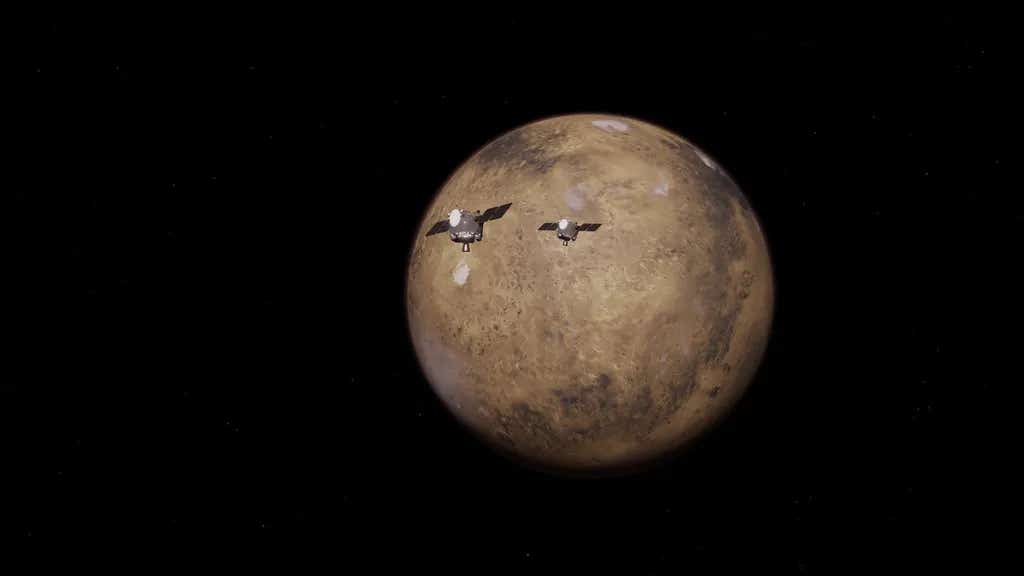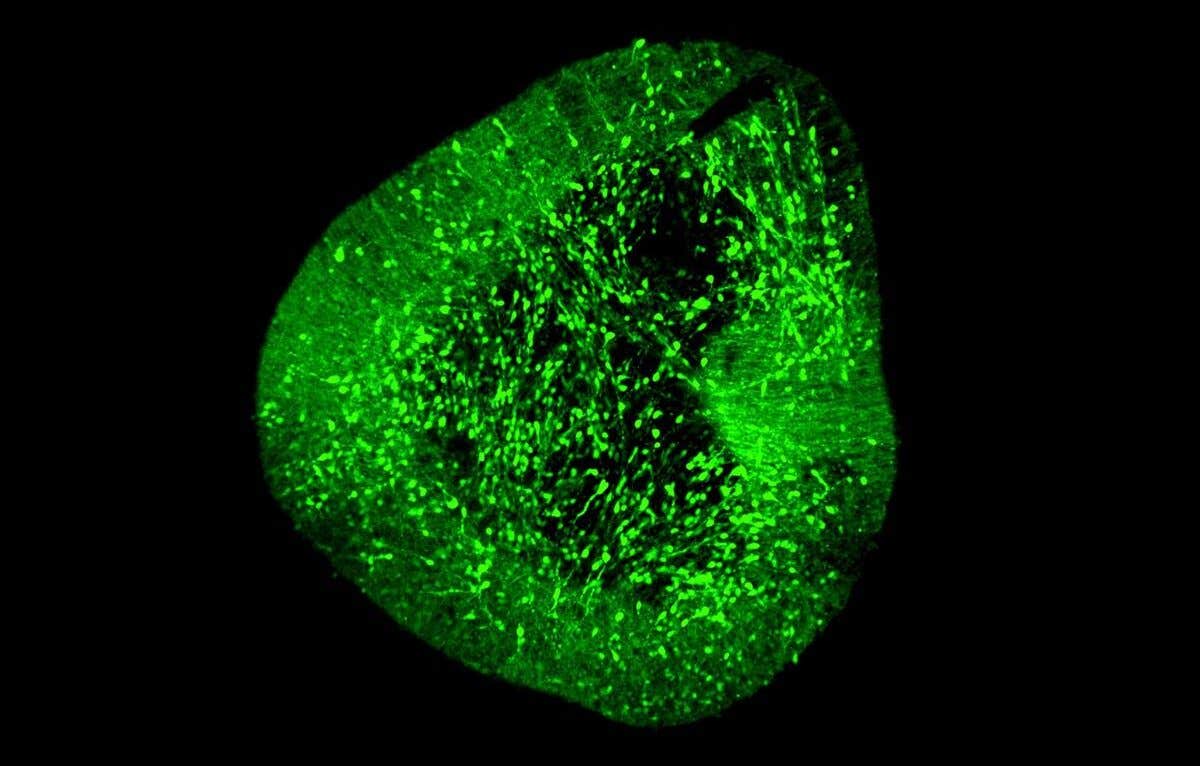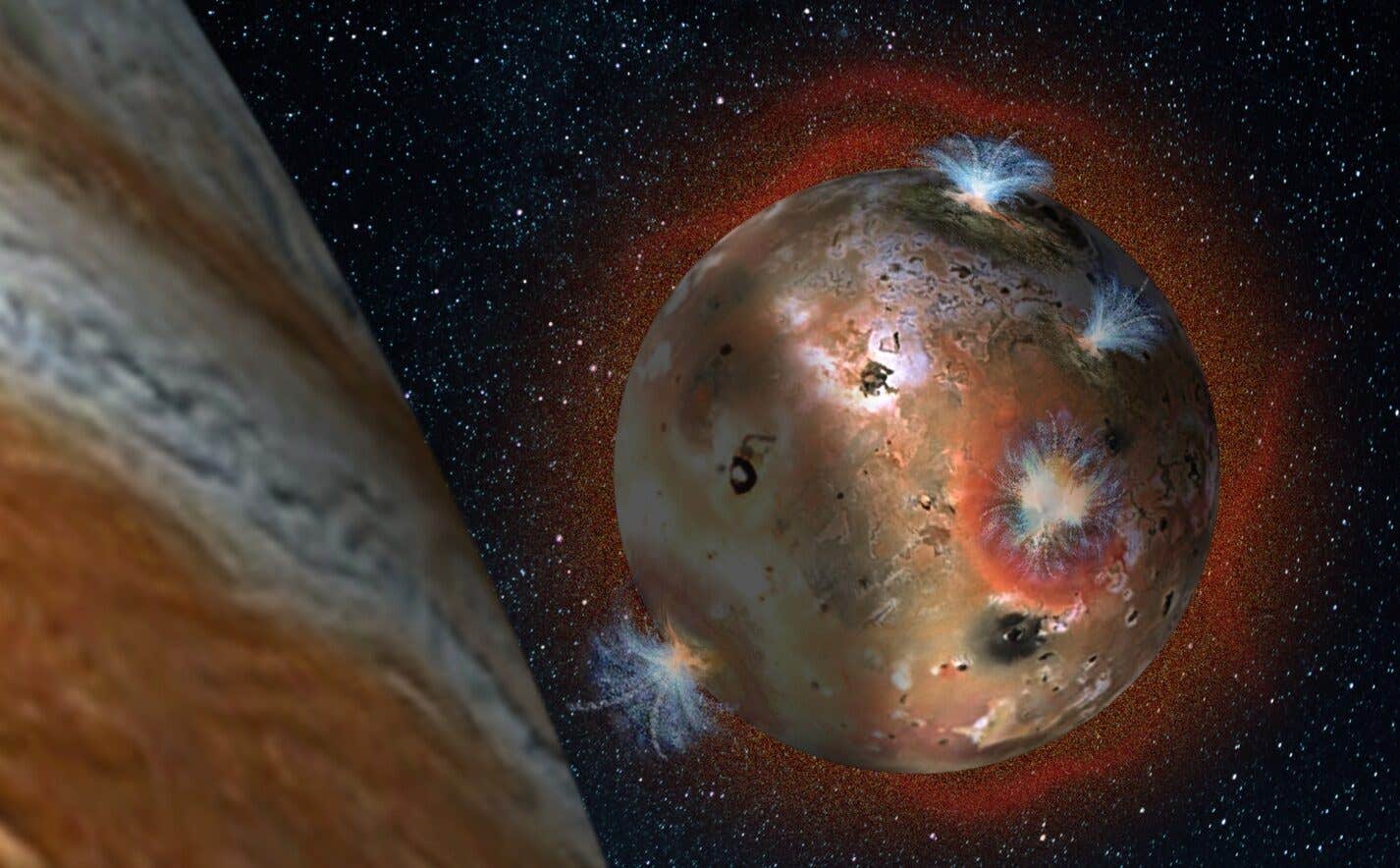UC Berkeley and NASA prepare twin satellites — could rewrite what we know about Mars
Mars does not have a protective magnetic field like Earth. Instead, it has scattered pockets of magnetized crust that create a patchwork of small magnetic shelters.

 Edited By: Joseph Shavit
Edited By: Joseph Shavit

Illustration of ESCAPADE twin spacecraft entering Mars’ orbit. (CREDIT: James Rattray/Rocket Lab USA)
The quiet hours before a rocket launch always carry a sense of hope, especially when a mission aims to answer old questions about a distant world. That feeling is strong as NASA gets ready to send a pair of identical satellites toward Mars. The mission, called ESCAPADE, is scheduled to lift off no earlier than Nov. 9 from Cape Canaveral in Florida. Once in space, the small orbiters will travel together to give scientists the first three-dimensional view of the magnetic environment that surrounds the Red Planet.
You follow the journey from Earth to Mars with a sense of curiosity because the results could shape the future for any person who dreams of standing on Martian soil one day. ESCAPADE, short for Escape and Plasma Acceleration and Dynamics Explorers, is managed and operated by the University of California, Berkeley.
Its twin satellites, nicknamed Blue and Gold, will map the magnetic fields, ionosphere and thin upper air around Mars. Their combined view is expected to reveal how the planet lost most of its atmosphere and what that means for possible settlers.
Why Mars Needs Closer Study
Mars does not have a protective magnetic field like Earth. Instead, it has scattered pockets of magnetized crust that create a patchwork of small magnetic shelters. Its weak atmosphere cannot shield the surface from solar storms, which send high-energy particles that can damage cellular DNA. People living on Mars would have to guard themselves carefully. Last year NASA’s Curiosity rover recorded a solar event that delivered in one day the amount of radiation the surface usually receives in about 100 days.
Robert Lillis, the mission’s principal investigator from UC Berkeley’s Space Sciences Laboratory, has spent years studying this harsh environment. “Understanding how the ionosphere varies will be a really important part of understanding how to correct the distortions in radio signals that we will need to communicate with each other and to navigate on Mars,” he said. His team hopes the mission will help forecast solar storms more accurately, giving future explorers precious time to seek shelter.
ESCAPADE’s instruments will measure charged particles, changing magnetic fields and the way the atmosphere reacts to gusts of solar wind that sweep past Mars at a million miles per hour. By watching these changes from two angles at once, scientists can study how energy flows through the space around the planet and how atmospheric gases escape into space. Over billions of years, that escape helped turn a once wetter world into the dry landscape seen today.
A New Route to the Red Planet
ESCAPADE is breaking tradition even before it arrives at Mars. Most spacecraft use a launch window that comes only once every 26 months, then follow a fuel-saving path called a Hohmann transfer. ESCAPADE will try something different.
After leaving Earth, the satellites will cruise toward a Lagrange point where the gravity from Earth and the sun balances out. They will take a slow, looping path around that region for almost a year before swinging back toward Earth. A close pass in late 2026 will give them the push they need to meet Mars in early 2027.
This new approach matters because a future with crewed missions will require far more launch opportunities. If hundreds of ships must reach Mars every alignment, delays due to weather or mechanical issues could cause major backups.
A flexible route like the one ESCAPADE tests may allow missions to depart over many months, then time their final boost to arrive when the planets line up. Jeffrey Parker of Advanced Space LLC has been working on the navigation plan and described the mission as a step toward more adaptable Mars travel.
What the Scientists Hope to Learn
For nearly 60 years, UC Berkeley teams have built instruments that helped unravel the history of Mars. Earlier missions revealed clues such as the ancient loss of the planet’s global magnetic field and new types of auroras that flicker across its sky. ESCAPADE continues that history with instruments designed to measure both ionized atoms and electrons escaping the planet.
Gwen Hanley of UC Berkeley explains that the analyzers will show where these particles move and how much energy they carry. That detail helps researchers learn whether particles fall back to the planet or escape forever. Phyllis Whittlesey, who leads the electron analyzer team, says the measurements will shed light on how the solar wind powers these motions.
Another major question concerns the fate of water. Evidence shows that Mars once had rivers and lakes, at least for short periods. Shaoxui Xu, the mission’s deputy principal investigator, notes that a thicker atmosphere would have been needed to keep that water from freezing or boiling away. “There are only two ways for atmosphere to leave, either go into the ground or escape to space, and there are a lot of studies showing that escape has been a very significant contributor,” she said.
ESCAPADE’s stereo view of the ionosphere may also help future communication systems. Radio signals that bounce off the ionosphere can travel across long distances on the surface, but those signals can change when the ionosphere shifts. Understanding those shifts is essential for navigation and daily life.
Building a Mission at Lower Cost
ESCAPADE began as a concept in 2016. NASA selected it for development under the agency’s SIMPLEx program, which funds small and creative planetary missions. The goal was to create a project that cost far less than a traditional Mars orbiter. Rocket Lab USA designed and built the spacecraft platforms, while NASA’s Goddard Space Flight Center provided the magnetic field sensor. Embry-Riddle Aeronautical University built a plasma detector, and Northern Arizona University contributed a camera.
The entire cost to bring the spacecraft to the launchpad was $49 million, which is a fraction of the price of past Mars missions. Lillis says advances in commercial spaceflight have made it possible to send two orbiters to Mars for what once would have covered only a small part of a single mission.
After arrival, the satellites will take several months to shift into matching orbits. Once aligned, they will chase each other around the planet like beads on a string. Their quick passes through the same region will let scientists watch changes develop over minutes instead of hours, which has never been possible at Mars.
Practical Implications of the Research
Even with all that knowledge, the idea of living on Mars remains daunting. Lillis points out that without protective pressure, your blood would boil. Safe living will likely require underground habitats and strict radiation limits. Still, he believes humans will try. “It is definitely going to be a challenge to establish a human settlement on Mars,” he said. “But, you know, humans are tenacious, right?”
ESCAPADE’s findings could shape the future of Mars exploration. A clearer view of the planet’s magnetic patches, atmospheric loss and radiation risks will help protect future travelers. Better models of solar storms can reduce danger during long missions.
The mission’s new flight path could also expand launch opportunities, which is vital if many ships need to travel during each planetary alignment.
Understanding how the ionosphere affects radio signals may lead to more reliable communication systems for future crews.
Related Stories
- Strange new mineral found on Mars points to past potential for life
- NASA rover discovery suggests Mars once hosted microbial life
- Why Mars became a desert while Earth stayed alive
Like these kind of feel good stories? Get The Brighter Side of News' newsletter.
Joshua Shavit
Science & Technology Writer and Editor
Joshua Shavit is a Los Angeles-based science and technology writer with a passion for exploring the breakthroughs shaping the future. As a co-founder of The Brighter Side of News, he focuses on positive and transformative advancements in AI, technology, physics, engineering, robotics and space science. Joshua is currently working towards a Bachelor of Science in Business and Industrial Engineering at the University of California, Berkeley. He combines his academic background with a talent for storytelling, making complex scientific discoveries engaging and accessible. His work highlights the innovators behind the ideas, bringing readers closer to the people driving progress.



